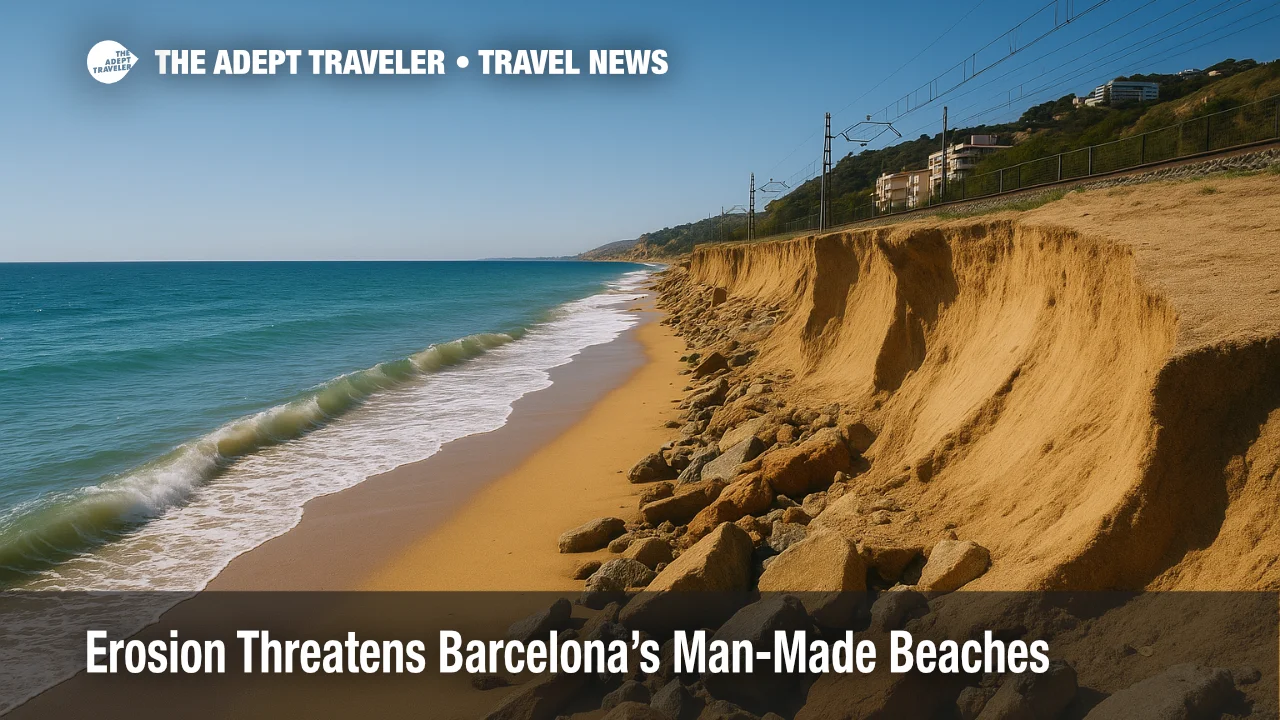Erosion Threatens Barcelona's Man-Made Beaches

Storm-driven swells and sea-level rise are stripping sand from Barcelona's engineered shoreline, jeopardizing summer traditions and the regional tourism economy. Locals in Montgat, a 30-minute drive north of the city, say each winter storm now bites deeper, shrinking the beach they rely on for recreation and income. Engineers warn that artificial beaches erode faster than natural ones, and recent data show Catalonia's sea level has climbed 14 centimetres in just 25 years. Officials are scrambling to slow the loss, but replacement sand and temporary breakwaters no longer keep pace. Without swift adaptation, Barcelona's celebrated coast could lose its primary draw-sun-and-sand leisure-for residents and travelers alike.
Key Points
- Why it matters: Montgat and other engineered beaches support a multimillion-euro summer tourism economy.
- Sea level along Catalonia's coast has risen fourfold faster since the 1990s, accelerating erosion.
- April 2024 storms built five-metre waves that erased whole beach sections within hours.
- Officials plan €60 million in shoreline defenses but admit sand replenishment alone is failing.
- Scientists urge permanent structures, vegetation buffers, and retreat strategies to protect rail lines and homes.
Snapshot
Montgat once thrived on fishing. After Barcelona won the 1992 Olympics, planners trucked in sand, converting rocky coves into wide, family-friendly beaches. Tourism surged, bars and seafood shacks multiplied, and day-trippers flooded the commuter rail from Plaça de Catalunya. Today, however, those Olympic-era beaches average only one-third their original width. Powerful DANA storms hammer the coast each autumn and winter, pulling sand offshore faster than councils can replace it. Residents fear the sea will next claim the rail embankment and beachfront cafés that animate summer evenings. With climate projections pointing to higher seas and heavier storms, the window for cost-effective fixes is closing rapidly.
Background
Europe is warming twice as fast as the global average, according to the EU's Copernicus Climate Change Service. Warmer water expands, glaciers melt, and coastal Spain faces a compound threat: higher baseline seas plus storm-surge peaks. Because Montgat's sand sits atop a man-made berm, it lacks the natural dune systems that absorb wave energy. Regional authorities have historically trucked in thousands of cubic metres of sand after severe winters, costing millions and lasting only a season or two. Breakwaters installed piecemeal trap sediment locally but starve down-drift beaches, shifting rather than solving the problem. Researchers from the Polytechnic University of Catalonia now push for integrated, basin-wide sediment management and "living shorelines" using native vegetation to bind sand.
Latest Developments
Engineers Call for Modular Breakwaters
Barcelona's Metropolitan Area agency has drafted a €60 million plan to install offshore, modular breakwaters at critical loss points, beginning in Montgat. Each low-crested structure would sit 300 feet from shore, reducing incoming wave energy by up to 40 percent. The design allows water circulation, preserving water quality and swimmer safety. Officials hope phased construction, paired with strategic sand fills, can stabilize 30 kilometres of beach by 2030. Funding remains uncertain, but local mayors argue that safeguarding coastline infrastructure, including the coastal rail line that carries 12 million passengers annually, justifies the investment.
Local Businesses Fear Economic Hit
Beach bars, surf schools, and small hotels drive Montgat's summer economy. Owners report bookings slipped 15 percent this June compared with 2023 as the usable beach area shrank. Ana García, who rents a seasonal beach shack, fears the shack's foundations may soon sit in the surf. Restaurant owner José Luís Vélez says repeat patrons already complain about narrower sunbathing space and exposed rock. Business leaders are lobbying Madrid for emergency climate-adaptation grants, arguing that tourism tax revenue will fall sharply if beaches disappear. Many now consider diversifying into shoulder-season cultural and culinary experiences to hedge against the threat.
Analysis
Barcelona's coastline illustrates a broader dilemma facing Mediterranean destinations built on sand replenishment: short-term fixes mask long-term vulnerability. Repeated nourishment buys time, yet each truckload becomes costlier as suitable offshore sand sources dwindle. Structural defenses-breakwaters, groynes, seawalls-offer stability but can disrupt marine ecosystems and alter sediment flows, provoking legal challenges. "Soft" options such as dune restoration and seagrass planting enhance resilience and biodiversity but require space that dense urban waterfronts lack. A hybrid strategy blending offshore breakwaters with periodic, smaller-scale nourishment and ecological buffers appears most practical. Crucially, governance must shift from municipal patch-ups to regional sediment planning that treats the coast as a single, dynamic system. Transparent communication will help travelers understand seasonal closures and ongoing works, preserving visitor confidence while adaptation unfolds.
Final Thoughts
Barcelona's golden fringe of sand helped transform the city into a global tourism icon after 1992. Climate-driven erosion now threatens that legacy. Swift, coordinated adaptation-engineering, ecological, and economic-can still protect summer traditions, local livelihoods, and the wider visitor economy. Delay will only narrow options as waves keep claiming territory along the Barcelona coastline erosion zone.
